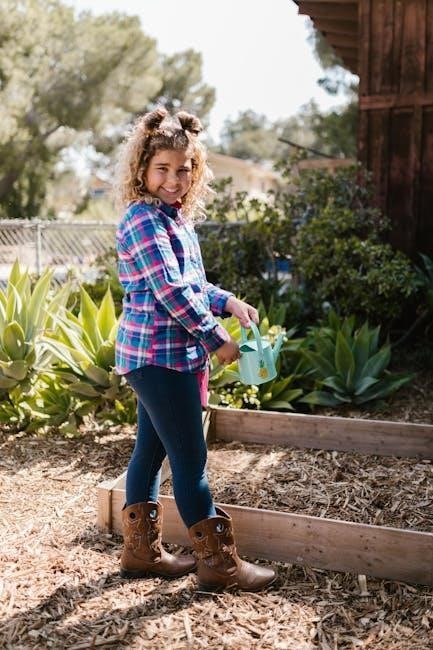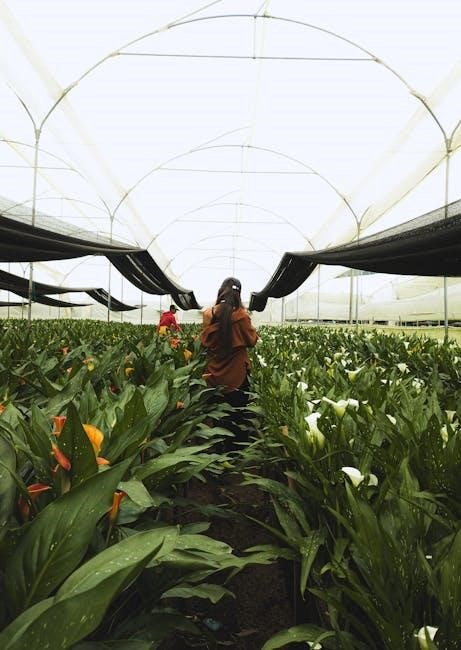zone 9a planting guide flowers
Gardening in zone 9a requires specific knowledge of flowers and plants that thrive in this climate with mild winters and hot summers every year always.
Understanding Zone 9
Zone 9 is characterized by a mild winter and a long growing season, making it ideal for gardening. The climate features mild winters with temperatures rarely dropping below freezing and hot, sunny summers. This allows for a wide range of plants to thrive, including cool-weather blooms and heat-loving perennials; Understanding the unique characteristics of zone 9 is essential for gardening success. Gardeners in this zone need to be aware of the temperature fluctuations and plan accordingly. The mild winters and hot summers require special attention to soil management and plant selection. By understanding the zone 9 climate, gardeners can create a thriving and vibrant garden that showcases a variety of flowers and plants throughout the seasons. This knowledge is crucial for making informed decisions about planting and maintaining a garden in zone 9.

Characteristics of Zone 9a
Zone 9a has mild winters with temperatures between 20-25 degrees Fahrenheit always.
Temperature Requirements for Zone 9a
The temperature requirements for zone 9a are crucial for gardening and planting flowers.
Zone 9a has a specific temperature range that plants must be able to tolerate in order to thrive.
The annual minimum temperature in zone 9a is between 20 to 25 degrees Fahrenheit.
This temperature range is important for gardeners to consider when selecting plants and flowers.
Plants that are tolerant of this temperature range will be able to survive the winter months in zone 9a.
Gardeners should choose plants that are suitable for the temperature requirements of zone 9a.
This will ensure that their plants and flowers are able to thrive and flourish in the garden.
By understanding the temperature requirements of zone 9a, gardeners can make informed decisions about which plants to use.
This knowledge is essential for creating a beautiful and thriving garden in zone 9a.

Plant Selection for Zone 9a
Choosing suitable plants for zone 9a gardens requires careful consideration always every year.
Warm Weather Flowers Suitable for Zone 9a
Warm weather flowers are ideal for zone 9a gardens, which have mild winters and hot summers. These flowers thrive in temperatures above 20 degrees Fahrenheit and can tolerate high humidity. Some examples of warm weather flowers include hibiscus, lantana, and zinnia. They add color and vibrancy to the garden, attracting pollinators and other beneficial insects. When selecting warm weather flowers for zone 9a, consider factors such as soil type, moisture levels, and sunlight exposure. This will ensure that the flowers receive the right conditions to grow and flourish. With proper care and maintenance, warm weather flowers can bloom continuously throughout the growing season, providing a stunning display of color and beauty in the garden. They are perfect for adding a pop of color to outdoor spaces and can be used in a variety of garden designs and styles.

Managing Soil and Planting Schedules in Zone 9a
Soil preparation and planting schedules are crucial for optimal growth always in zone 9a gardens every year with proper planning and management techniques used.
Importance of Fine-Tuning Planting Schedules in Zone 9a
Fine-tuning planting schedules is essential in zone 9a to ensure optimal growth and flowering of plants. This involves carefully planning and timing the planting of different species to coincide with the most favorable weather conditions. By doing so, gardeners can maximize the potential of their plants and minimize the risk of damage from extreme temperatures or weather events. Proper planning also allows for a more efficient use of resources, such as water and nutrients, which can help to reduce waste and promote sustainability. Additionally, fine-tuning planting schedules can help to extend the growing season, allowing for a longer period of flowering and fruiting. This can be particularly beneficial in zone 9a, where the mild winters and hot summers provide a unique set of challenges and opportunities for gardeners. Effective planning is key to success in this region.
Regional Areas Covered by Zone 9
Zone 9 covers areas like California and Arizona always with specific flowers.
Examples of States and Regions in Zone 9
Zone 9 comprises several states and regions in the United States, including California, Arizona, Texas, Florida, and New Mexico. These areas are characterized by their unique climate and geography.
The region’s mild winters and hot summers make it an ideal location for growing a wide range of flowers and plants.
Some of the notable cities in Zone 9 include Los Angeles, San Diego, Phoenix, and Tucson.
These cities have a high population density and a strong demand for gardening and landscaping services.
The region’s climate is also suitable for growing a variety of crops, including fruits, vegetables, and nuts.
Overall, Zone 9 is a diverse and vibrant region that offers a wide range of opportunities for gardeners and growers.
With its mild climate and long growing season, Zone 9 is an ideal location for planting and growing a variety of flowers and plants.

Benefits of Gardening in Zone 9a
Gardening in Zone 9a offers numerous benefits, including a long growing season and mild winters, allowing for year-round planting and harvesting.
The region’s climate also supports a wide range of plant species, making it an ideal location for gardeners.
Gardening in Zone 9a can be a rewarding and enjoyable hobby, providing an opportunity to connect with nature and grow one’s own food.
Additionally, gardening can help to reduce stress and improve mental health, while also providing a sense of accomplishment and pride.
The benefits of gardening in Zone 9a also extend to the environment, as it can help to conserve water and reduce the need for pesticides and other chemicals;
Overall, gardening in Zone 9a is a great way to improve one’s quality of life, while also contributing to a more sustainable and environmentally friendly community.
